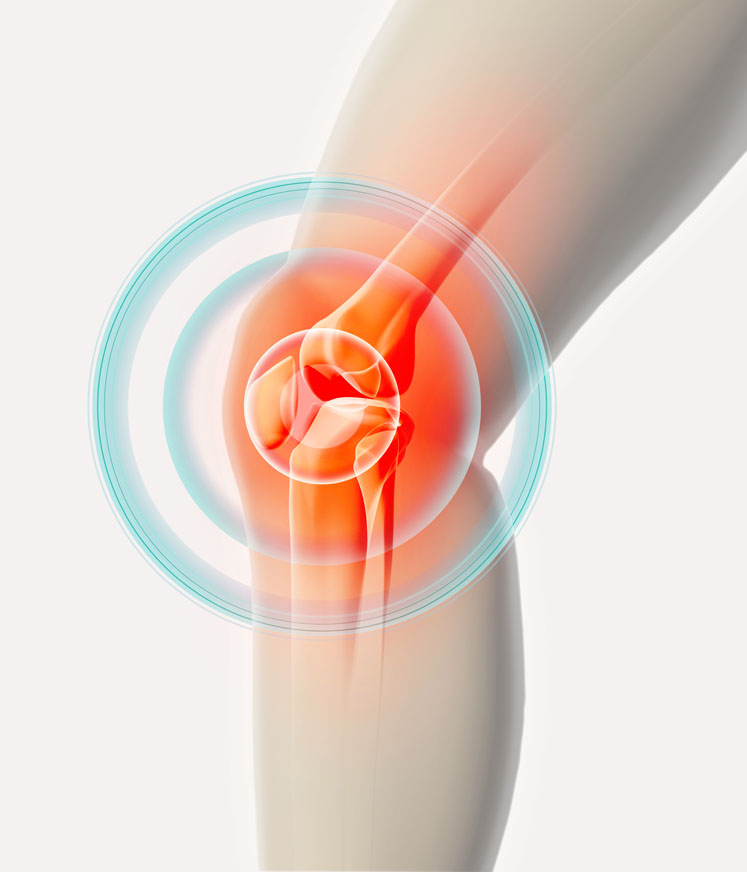In the UK, 54% of adults older than 45 were suffering from multisite peripheral joint pain in 2017.
In the US, the United States National Health Interview Survey estimated that 52.5 million adults had been diagnosed with arthritis and that 22.7 million others were affected by arthritis and arthritis-attributable activity limitations. It has been estimated that by 2030, 67 million people will be diagnosed with arthritis.1
Two pillars of Ayurvedic joint health
Turmeric (Curcuma longa), the well-known Indian spice, and Boswellia serrata have been used for more than 2500 years in Ayurvedic medicine to treat a variety of ailments, of which joint pain is an important one.
The ability of curcumin, the active principle of turmeric, to slow and relieve joint pain has been explained with various animal models. In an osteoarthritis (OA) exemplar using destabilisation of the medial meniscus (DMM), orally administrated curcumin significantly reduced OA disease progression.2
Curcumin has been found to have anti-inflammatory activity by inhibiting the enzymes and cytokines involved in cell membrane inflammation, such as OLA2, COX-2 and 5-LOX, and by inhibiting the transcription of NF-ϏB, which is the nuclear factor that induces the enhancement of proinflammatory cytokines.
Experiments on cultured human rheumatoid arthritis (RA) synovial fibroblasts from patients have shown that inhibiting NF-ϏB activation and nuclear translocation suppresses IL-1β and OSM-induced MMP-1, MMP-3, MMP-9 and MMP-13 gene expression in human chondrocytes, which are responsible for collagen and cartilage degradation.3
A randomised comparative pilot study showed that RA patients treated with curcumin showed the highest levels of improvement compared with those treated with sodium diclofenac.4

In another trial investigating the clinical efficacy of curcuminoids in patients suffering from knee OA, patients assigned to curcuminoids (1500 mg/day in three divided doses for 6 weeks) had a significantly greater reduction in joint pain scores compared with a placebo.5
Vidya Herbs has developed a naturally enhanced curcumin (Vi-Active) with a bioavailability that’s 2.2-times higher than standard curcumin. Marketed under the brand name, Puremeric, Vidya’s turmeric extracts are characterised by three curcuminoids.
HPLC profiling, isotopic 14C analysis and DNA testing ensure the natural origin and absence of synthetic substitutions. The botanical variety is guaranteed by a botanist and complete traceability is ensured through the Full-iD internal quality system.
Puremeric extracts also benefit from SFTTM natural technology, which combines easier product formulation with streamlined production while maintaining clean labelling.Boswellia serrata
Boswellic acid and 3-O-acetyl-11-keto-beta-boswellic acid (AKBA) are the most active components of Boswellia serrata. AKBA has been demonstrated to be a potent inhibitor of 5-LOX, the key enzyme responsible for leukotriene biosynthesis from arachidonic acid in the cellular inflammatory cascade.
Boswellic acid and AKBA have been shown to decrease the production of proinflammatory cytokines (such as IL-1, IL-2, IL-6, IFN-γ and TNF-α) that destroy joint tissues and cartilage.
In a double-blind, placebo-controlled trial, knee OA patients given daily doses of 1000 mg of Boswellia extract for 8 weeks experienced a significant decrease in pain and swelling and an increase in range of motion compared with the placebo.6
But Boswellia serrata is also interesting for its analgesic properties. This effect has been confirmed in a healthy human volunteer pain model experiment by demonstrating increased threshold, tolerance force and time results.7
In addition, a double-blind, randomised, placebo-controlled study showed that a 30% AKBA Boswellia extract could reduce pain and significantly improve physical function in OA patients.
Reducing the enzymatic degradation of cartilage was identified as a mechanism of action.8
Vidya Herbs offers extracts from 30–90% boswellic acid or standardised at 30% AKBA content. All our Boswellia extracts are completely traceable with botanical certificates of origin and comply with the highest standards of quality.
Moreover, the association between these two plants presents a potent and efficient combination. A mixture of Curcuma longa and Boswellia serrata has been shown to be more efficient than a standard dose of Celecoxib (a selective COX-2 inhibitor) in the treatment of osteoarthritis, both objectively and subjectively improving the condition of patients, with no toxicity detectable by clinical examination and laboratory tests.9
Plants could also be a natural source of the vitamins and minerals that are necessary for joint health and stronger bones.
Vitamin C from amla
Deficiencies in vitamin C can lead to the well-known scurvy, which, among other ailments, causes gingiva and bone pain. This is because vitamin C is a critical modulator of the production and maturation of collagen, which is a key component of the extracellular matrix of bones and cartilage.
As such, vitamin C may also benefit people with early osteoarthritis. Using a gentle production process, Vidya Herbs offers an extract of amla (Emblica officinalis) that’s standardised at 15% vitamin C.
As a result of certain health conditions, such as lactose intolerance or simply adopting a vegetarian or vegan diet, some individuals may not be getting all the minerals they need to reinforce their bones.
Calcium from sesame seeds
Osteoporosis is a disease characterised by porous and fragile bones. It primarily affects elderly people and is frequently associated with fractures of the hip, vertebrae, wrist, pelvis, ribs, and other bones.
Avoiding movement owing to joint pain may result in fragile bones. The dietary calcium deficiencies identified in some population groups may be addressed in several ways.
Vidya herbs has developed Nutrisesa, a sesame (Sesamum indicum L.) husk water extract that is fully traceable from the field to the product. It is backed by a botanical certificate of origin, complies with the highest standards of quality and comprises 13% naturally occurring calcium.
Zinc from guava
Zinc is the most abundant mineral in the body after iron. Bones contains approximately 30% of the body’s total zinc content. Zinc is an important element for bone and cartilage development, regeneration and homeostasis; its deficiency was found to give rise to bone growth retardation.
Guava (Psidium guajava) is very well known for its fruit; however, all parts of the tree have been used to treat medical ailments. Vidya Herbs extracts guava leaves, known to be rich in minerals, to produce a 4% zinc powder ingredient.
Selenium from Indian mustard
Selenium deficiency and the dysregulation of selenoproteins are associated with impaired homeostasis redox in cartilage.
In the human knee joint, the selenium concentration in cartilage is approximately 80 μg/kg dry weight, whereas the selenium concentrations in ligament and meniscus are 270 and 307 μg/kg dry weight, respectively.
Adequate physiological selenium levels to maintain cartilage homeostasis are required. By a selection of soil cultivation and appropriate gentle technologies, Vidya Herbs has created a 0.5% selenium extract of Indian mustard (Brassica juncea).
Conclusion
Before reaching for natural solutions such as curcumin and Boswellia to treat joint pain and disorders, consumers should also consider getting the vitamins and minerals necessary for bone and joint homeostasis from vegetal sources.
Natural products obtained by Vidya Herbs, combining Ayurvedic traditions and modern science, include high quality herbal extracts and provide natural and efficient joint and bone health solutions for demanding consumers looking for alternative solutions.
References
- https://s3.amazonaws.com/rdcms-iasp/files/production/public/Content/ContentFolders/GlobalYearAgainstPain2/2016/FactSheets/English/11.%20Joint%20Pain%20Epidemiology.pdf.
- Z. Zhang, et al., “Curcumin Slows Osteoarthritis Progression and Relieves Osteoarthritis-Associated Pain Symptoms in a Post-Traumatic Osteoarthritis Mouse Model,” Arthritis Research & Therapy 18, 128 (2016).
- Y. Henrotin, et al., “Biological Actions of Curcumin on Chondrocytes,” Osteoarthritis and Cartilage 18, 141–149 (2010).
- B. Chandran and A. Goel, “A Randomized Pilot Study to Assess the Efficacy and Safety of Curcumin in Patients with Active Rheumatoid Arthritis,” Phytother. Res. 26, 1719–1725 (2012).
- Y. Panahi, et al., “Curcuminoid Treatment for Knee Osteoarthritis: A Randomized Double-Blind Placebo-Controlled Trial,” Phytother. Res. 28(11), 1625–1631 (2014).
- N. Kimmatkar, et al., “Efficacy and Tolerability of Boswellia serrata Extract in Treatment of Osteoarthritis of Knee – A Randomized Double-Blind Placebo Controlled Trial,” Phytomedicine 10, 3–7 (2003).
- K. Prabhavathi, et al., “A Randomized, Double-Blind, Placebo-Controlled, Crossover Study to Evaluate the Analgesic Activity of Boswellia serrata in Healthy Volunteers Using Mechanical Pain Model,” Indian J. Pharmacol. 46(5), 475–479 (2014).
- K. Sengupta, et al., “A Double-Blind, Randomized, Placebo-Controlled Study of the Efficacy and Safety of 5-Loxin for Treatment of Osteoarthritis of the Knee,” Arthritis Research & Therapy 10(4), 1–11 (2008).
- R. Kizhakkedath, “Clinical Evaluation of a Formulation Containing Curcuma longa and Boswellia serrata Extracts in the Management of Knee Osteoarthritis,” Mol. Med. Rep. 8(5), 1542–1548 (2013).




